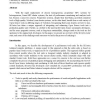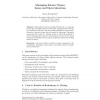4209 search results - page 62 / 842 » Software Change and Evolution |
IWPSE
2003
IEEE
14 years 29 days ago
2003
IEEE
Avoiding architectural erosion helps extend the lifetime of an evolving software system. Erosion can be reduced by ensuring that (i) developers share a good understanding of a sys...
CISIS
2010
IEEE
2010
IEEE
Computational Grid as an Appropriate Infrastructure for Ultra Large Scale Software Intensive Systems
14 years 2 months ago
—Ultra large scale (ULS) systems are future software intensive systems that have billions of lines of code, composed of heterogeneous, changing, inconsistent and independent elem...
TSE
2008
13 years 7 months ago
2008
The Unified Modeling Language (UML) is the de facto standard for object-oriented software analysis and design modeling. However, few empirical studies exist which investigate the c...
CONCURRENCY
2010
13 years 7 months ago
2010
With the rapid replacement of closed, homogeneous, proprietary HPC systems by heterogeneous, Linux-MPI cluster systems, the state of performance monitoring and analysis tools has ...
DAGSTUHL
2006
13 years 9 months ago
2006
Many software systems contained cloned code, i.e., segments of code that are highly similar to each other, typically because one has been copied from the other, and then possibly m...


